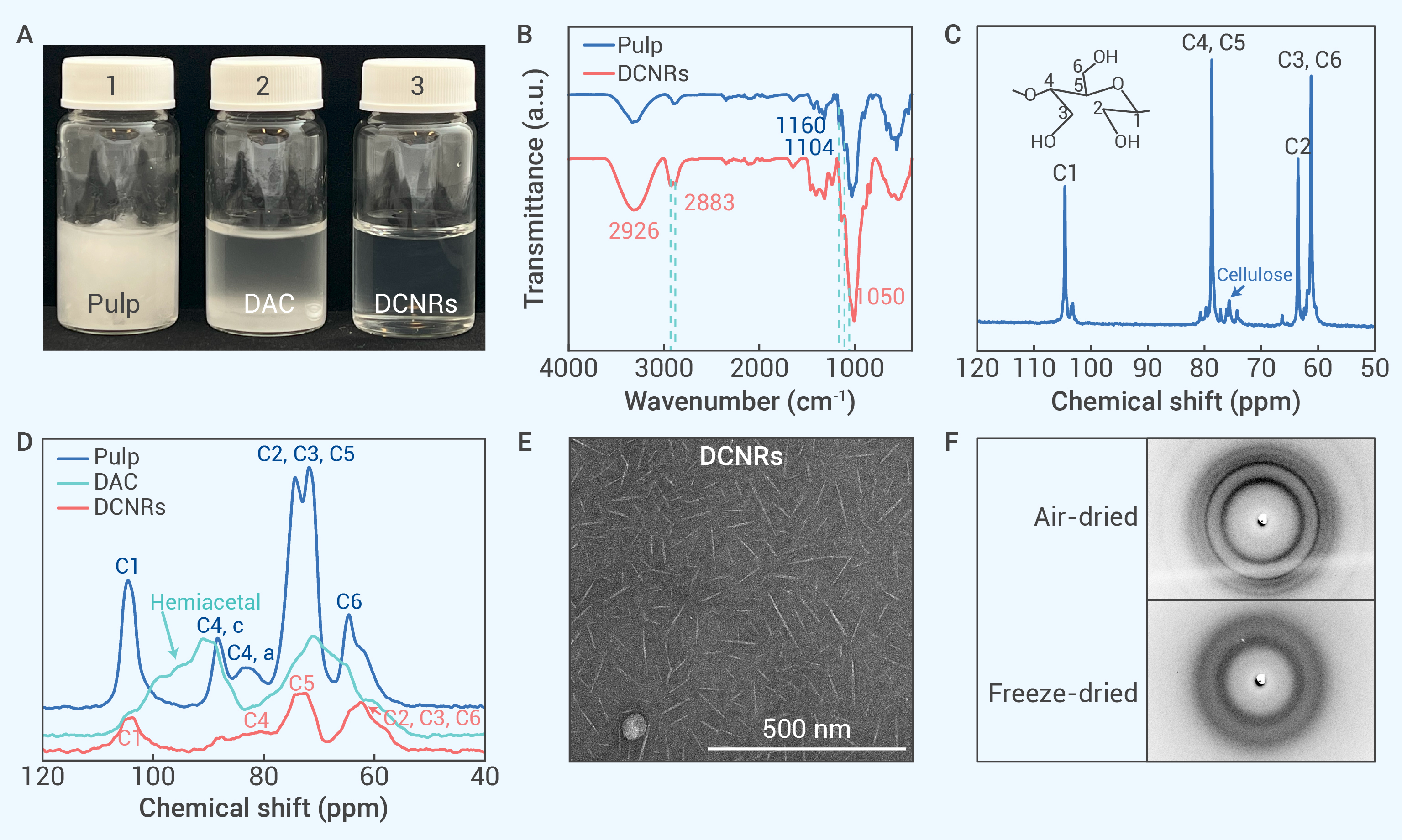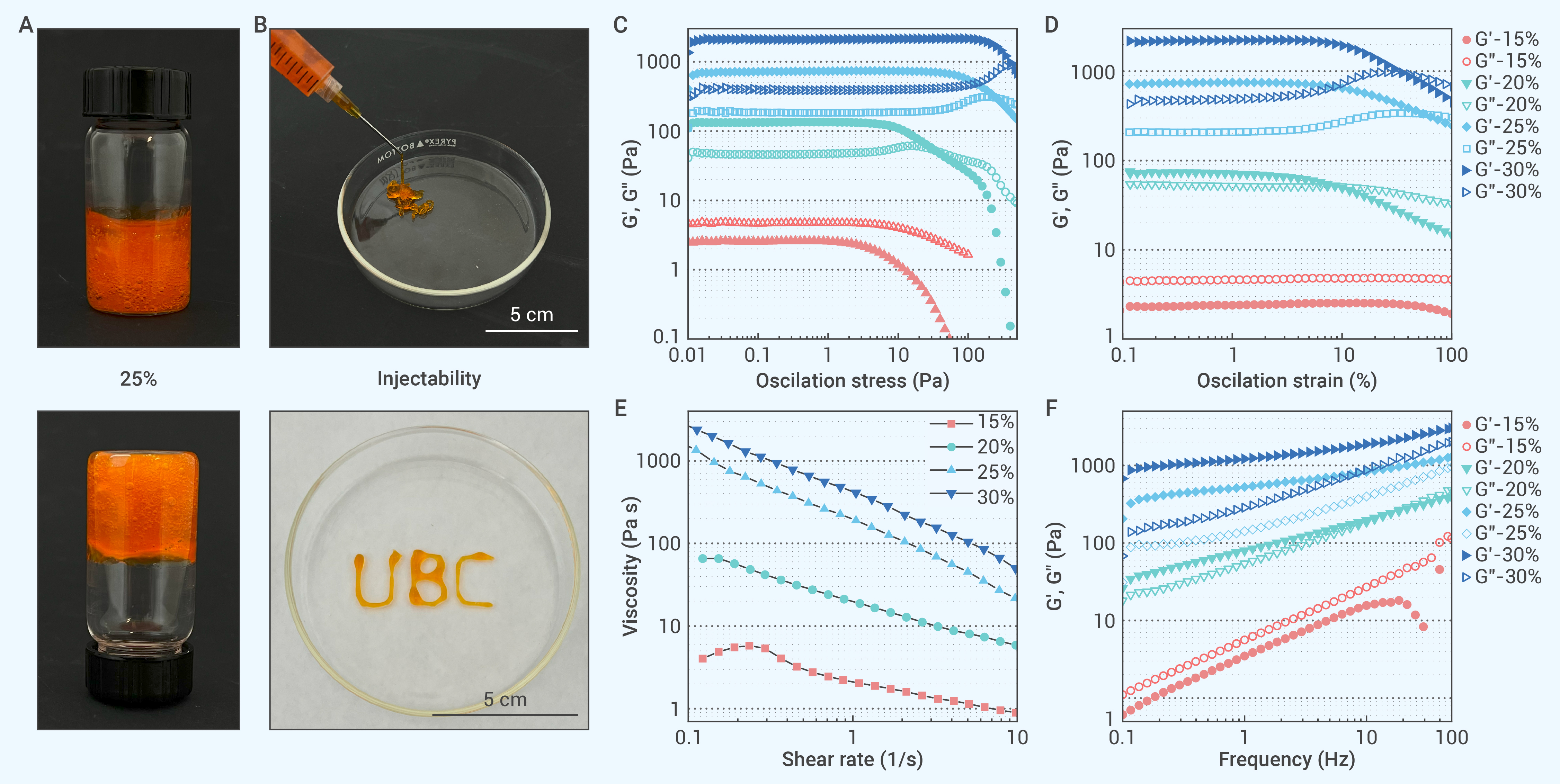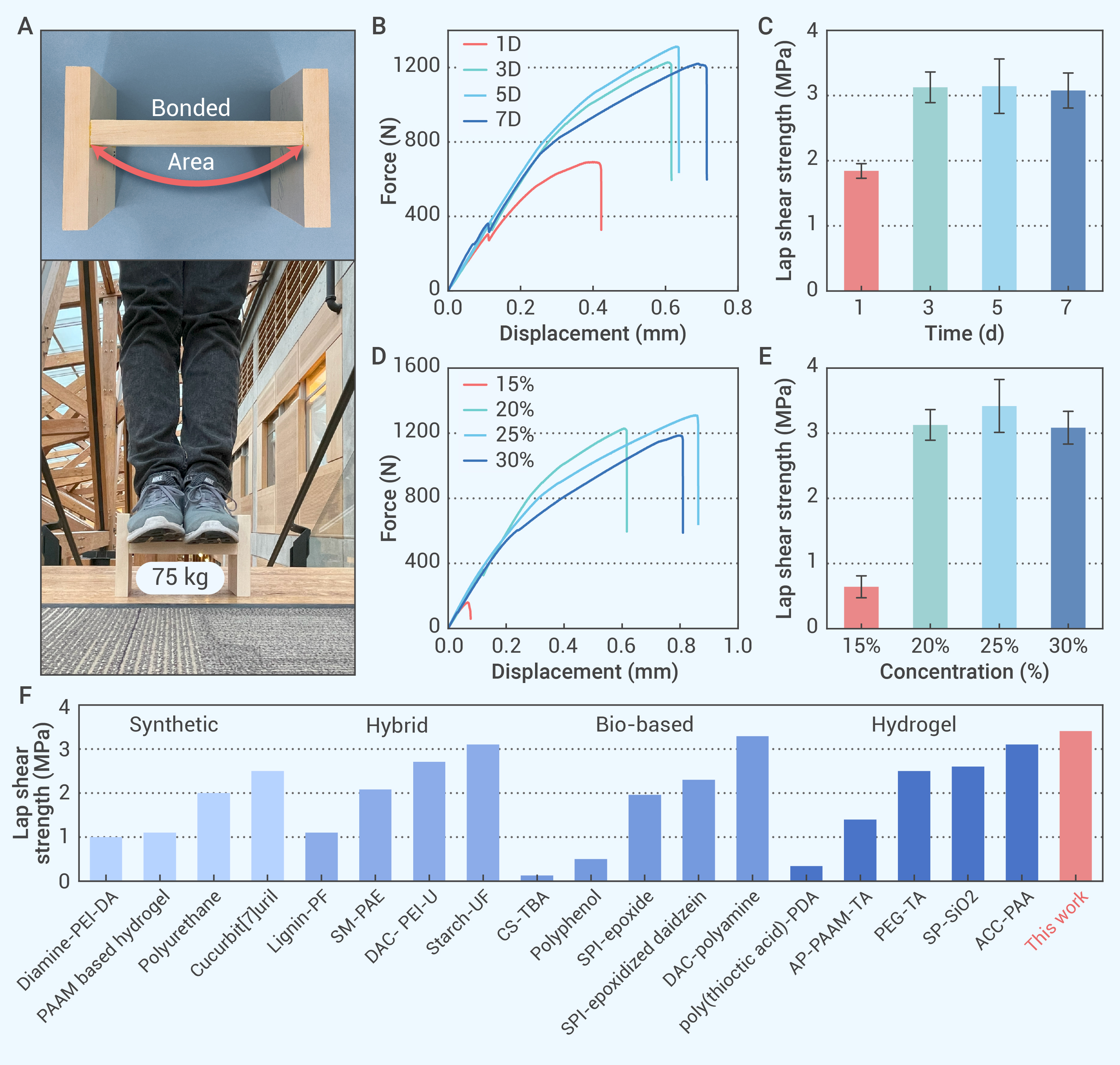-
GRAPHICAL ABSTRACT

-
PUBLIC SUMMARY
-
Dialcohol cellulose nanorods are prepared through sequential oxidation and reduction.
Primary hydroxyl groups bring about more out-of-plane hydrogen bonds.
Concentrated dialcohol cellulose nanorods can form an all-cellulose hydrogel.
The all-cellulose hydrogel shows high adhesion to various substrates.
-
-
ABSTRACT
Hydrogels showing strong adhesion to different substrates have garnered significant attention for engineering applications. However, the current development of such hydrogel-based adhesive is predominantly limited to synthetic polymers, owing to their exceptional performance and an extensive array of chemical options. To advance the development of sustainable hydrogel-based adhesives, we successfully create a highly robust all-cellulose hydrogel-based adhesive, which is composed of concentrated dialcohol cellulose nanorods (DCNRs) and relies on enhanced hydrogen bonding interactions between cellulose and the substrate. We implement a sequential oxidization-reduction process to achieve this high-performance all-cellulose hydrogel, which is realized by converting the two secondary hydroxyl groups within an anhydroglucose unit into two primary hydroxyl groups, while simultaneously linearizing the cellulose chains. Such structural and chemical modifications on cellulose chains increase out-of-plane interactions between the DCNRs hydrogel and substrate, as simulations indicate. Additionally, these modifications enhance the flexibility of the cellulose chains, which would otherwise be rigid. The resulting all-cellulose hydrogels demonstrate injectability and strong adhesion capability to a wide range of substrates, including wood, metal, glass, and plastic. This green and sustainable all-cellulose hydrogel-based adhesive holds great promise for future bio-based adhesive design. -

-
REFERENCES
[1] Li, A., Jia, Y., Sun, S., et al. (2018) Mineral-enhanced polyacrylic acid hydrogel as an oyster-inspired organic–inorganic hybrid adhesive. ACS Appl. Mater. Interfaces. 10 , 10471-10479. [2] Pang, H., Yan, Q., Ma, C., et al. (2021) Polyphenol-metal ion redox-induced gelation system for constructing plant protein adhesives with excellent fluidity and cold-pressing adhesion. ACS Appl. Mater. Interfaces. 13 , 59527-59537. [3] Choi, Y., Kang, K., Son, D., et al. (2022) Molecular rationale for the design of instantaneous, strain-tolerant polymeric adhesive in a stretchable underwater human–machine interface. ACS Nano 16 , 1368-1380. [4] Pei, X., Wang, J., Cong, Y., et al. (2021) Recent progress in polymer hydrogel bioadhesives. J. Polym. Sci. 59 , 1312-1337. [5] Zhang, W., Hu, J., Yang, H., et al. (2021). Fatigue-resistant adhesion ii: swell tolerance. extrem. Mech. Lett. 43, 101182. [6] Zhang, W., Gao, Y., Yang, H., et al. (2020). Fatigue-resistant adhesion I. Long-chain polymers as elastic dissipaters. Extrem. Mech. Lett. 39, 100813. [7] Sun, J., Tan, H., Liu, H., et al. (2020). A reduced polydopamine nanoparticle-coupled sprayable PEG hydrogel adhesive with anti-infection activity for rapid wound sealing. Biomater. Sci. 8, 6946−6956. [8] Oelker, A.M., Berlin, J.A., Wathier, M., and Grinstaff, M.W. (2011). Synthesis and characterization of dendron cross-linked peg hydrogels as corneal adhesives. Biomacromolecules 12, 1658−1665. [9] Wang, J., Zhang, N., Tan, Y., et al. (2022). Sweat-Resistant Silk Fibroin-Based Double Network Hydrogel Adhesives. ACS Appl. Mater. Interfaces. 14, 21945−21953. [10] Yan, Y., Xu, S., Liu, H., et al. (2020). A multi-functional reversible hydrogel adhesive. Colloids Surfaces A Physicochem. Eng. Asp. 593, 124622. [11] Yuk, H., Varela, C.E., Nabzdyk, C.S., et al. (2019). Dry double-sided tape for adhesion of wet tissues and devices. Nature 575, 169−174. [12] Joshi, S., Mahadevan, G., Verma, S., and Valiyaveettil, S. (2020). Bioinspired adenine–dopamine immobilized polymer hydrogel adhesives for tissue engineering. Chem. Commun. 56, 11303−11306. [13] Zhang, J.N., Zhu, H., Liu, T., et al. (2020). Strong adhesion of hydrogels by polyelectrolyte adhesives. Polymer (Guildf). 206, 122845. [14] Kim, K., Shin, M., Koh, M., et al. (2015). TAPE : a medical adhesive inspired by a ubiquitous compound in plants. Adv. Func. Mater. 25, 2402−2410. [15] Chen, K., Lin, Q., Wang, L., et al. (2021). An all-in-one tannic acid-containing hydrogel adhesive with high toughness , notch insensitivity , self-healability , tailorable topography , and strong , instant , and on-demand underwater adhesion. ACS Appl. Mater. Interfaces. 13, 9748−9761. [16] Yang, J., Bai, R., and Suo, Z. (2018). Topological adhesion of wet materials. Adv. Mater. 30, 1800671. [17] Hong, S., Pirovich, D., Kilcoyne, A., et al. (2016). Supramolecular metallo-bioadhesive for minimally invasive use. Adv. Mater. 28, 8675−8680. [18] Yuan, J., Du, G., Yang, H., et al. (2022). Functionalization of cellulose with amine group and cross-linked with branched epoxy to construct high-performance wood adhesive. Int. J. Biol. Macromol. 222, 2719−2728. [19] Zhao, D., Zhu, Y., Cheng, W., Xu, G., Wang, Q., Liu, S., Li, J., Chen, C., Yu, H., and Hu, L. (2020). A dynamic gel with reversible and tunable topological networks and performances. Matter 2, 390−403. [20] Liu, S., Du, G., Yang, H., et al. (2021). Developing high-performance cellulose-based wood adhesive with a cross-linked network. ACS Sustain. Chem. Eng. 9, 16849−16861. [21] Tardy, B.L., Richardson, J.J., Greca, L.G., et al. (2020). Exploiting supramolecular interactions from polymeric colloids for strong anisotropic adhesion between solid surfaces. Adv. Mater. 32, 1906886. [22] Liu, J., Li, J., Yu, F., et al. (2020). In situ forming hydrogel of natural polysaccharides through Schiff base reaction for soft tissue adhesive and hemostasis. Int. J. Biol. Macromol. 147, 653−666. [23] Zeng, Z., Mo, X., He, C., et al. (2016). An in situ forming tissue adhesive based on poly(ethylene glycol)-dimethacrylate and thiolated chitosan through the Michael reaction. J. Mater. Chem. B 4, 5585−5592. [24] Wang, J., Wang, L., Wu, C., et al. (2020). Antibacterial zwitterionic polyelectrolyte hydrogel adhesives with adhesion strength mediated by electrostatic mismatch. ACS Appl. Mater. Interfaces. 12, 46816−46826. [25] Fan, H., Wang, J., and Jin, Z. (2018). Tough, swelling-resistant, self-healing, and adhesive dual-cross-linked hydrogels based on polymer-tannic acid multiple hydrogen bonds. Macromolecules 51, 1696−1705. [26] Wu, J., Zhang, Z., Wu, Z., et al. (2022). Strong and ultra‐tough supramolecular hydrogel enabled by strain‐induced microphase separation. Adv. Funct. Mater. 33, 2210395. [27] Liu, H., Hu, X., Li, W., et al. (2023). A highly-stretchable and adhesive hydrogel for noninvasive joint wound closure driven by hydrogen bonds. Chem. Eng. J. 452, 139368. [28] Zhao, X., Liang, Y., Huang, Y., et al. (2020). Physical double-network hydrogel adhesives with rapid shape adaptability, fast self-healing, antioxidant and NIR/pH stimulus-responsiveness for multidrug-resistant bacterial infection and removable wound dressing. Adv. Funct. Mater. 30, 1910748. [29] Chen, J., Wang, D., Wang, L.H., et al. (2020). An adhesive hydrogel with “load-sharing” effect as tissue bandages for drug and cell delivery. Adv. Mater. 32, 2001628. [30] Zhao, D., Pang, B., Zhu, Y., et al. (2022). A stiffness-switchable, biomimetic smart material enabled by supramolecular reconfiguration. Adv. Mater. 34, 2107857. [31] Zhu, Y., Guo, Y., Cao, K., et al. (2023). A general strategy for synthesizing biomacromolecular ionogel membranes via solvent-induced self-assembly. Nat. Synth. 2, 864−872. [32] Ng, H.M., Sin, L.T., Bee, S.T., et al. (2017). Review of nanocellulose polymer composite characteristics and challenges. Polym. - Plast. Technol. Eng. 56, 687−731. [33] Thomas, B., Raj, M.C., Athira, B.K., et al. (2018). Nanocellulose, a versatile green platform: from biosources to materials and their applications. Chem. Rev. 118, 11575−11625. [34] Merindol, R., Diabang, S., Mujica, R., et al. (2020). Assembly of anisotropic nanocellulose films stronger than the original tree. ACS Nano 14, 16525−16534. [35] Li, K., Skolrood, L.N., Aytug, T., et al. (2019). Strong and tough cellulose nanofibrils composite films: mechanism of synergetic effect of hydrogen bonds and ionic interactions. ACS Sustain. Chem. Eng. 7, 14341−14346. [36] Jiang, G., Wang, G., Zhu, Y., et al. (2022). A scalable bacterial cellulose ionogel for multisensory electronic skin. Research 2022, 9814767. [37] Huang, J., Yu, L., Wang, S., et al. (2023). An ultrathin nanocellulosic ion redistributor for long-life zinc anode. Innov. Mater. 1, 100029. [38] Sun, X., Zhu, Y., Yu, Z., et al. (2023). Dialcohol cellulose nanocrystals enhanced polymerizable deep eutectic solvent-based self-healing ion conductors with ultra-stretchability and sensitivity. Adv. Sens. Res. 2, 2200045. [39] Kristiansen, K.A., Potthast, A., Christensen, B.E. (2010) Periodate oxidation of polysaccharides for modification of chemical and physical properties. Carbohydr. Res. 345 , 1264. [40] Casu, B., Naggi, A., Torri, G., et al. (1985). Stereoregular acyclic polyalcohols and polyacetates from cellulose and amylose. Macromolecules 18, 2762−2767. [41] Painter, T.J. (1988). Control of depolymerisation during the preparation of reduced dialdehyde cellulose. Carbohydr. Res. 179, 259−268. [42] Liu, C., Xie, X., Kong, X., et al. (2022) A removable, antibacterial and strong adhesive based on hyperbranched catechol polymers. Mater. Lett. 316 , 132019. [43] Borrero-López, A.M., Guzmán, D.B., González-Delgado, J.A., et al. (2021) Toward UV-triggered curing of solvent-free polyurethane adhesives based on castor oil. ACS Sustain. Chem. Eng, 9 , 11032-11040. [44] Liu, J., Scherman, O.A. (2018) Cucurbit [n] uril supramolecular hydrogel networks as tough and healable adhesives. Adv. Funct. Mater. 28 , 1800848. [45] Xu, C., Xu, Y., Chen, M., et al. (2020) Soy protein adhesive with bio-based epoxidized daidzein for high strength and mildew resistance. Chem. Eng. J. 390 , 124622. [46] Pan, F., Ye, S., Wang, R., et al. (2020) Hydrogel networks as underwater contact adhesives for different surfaces. Mater. Horizons 7 , 2063-2070. [47] Islam, M.N., Faruk, M.O., Rana, M.N., et al. (2021) Preparation and evaluation of rice bran‐modified urea formaldehyde as environmental friendly wood adhesive. Glob. Challenges 5 , 2000044. [48] He, X., Liu, R., Liu, H., et al. (2021) Facile preparation of tunicate-inspired chitosan hydrogel adhesive with self-healing and antibacterial properties. Polymers 13 , 4322. [49] Li, Z., Du, G., Yang, H., et al. (2022) Construction of a cellulose-based high-performance adhesive with a crosslinking structure bridged by Schiff base and ureido groups. Int. J. Biol. Macromol. 223 , 971. [50] Huang, X., Chen, Y., Li, J., et al. (2022) Improving the coating and prepressing properties of soybean meal adhesive by constructing a biomimetic topological structure. Mater. Des. 223 , 111163. [51] Zhang, X., Xu, C., Liu, Z., et al. (2022) A water-resistant and mildewproof soy protein adhesive enhanced by epoxidized xylitol. Ind. Crops Prod. 180 , 114794. [52] Huang, C., Peng, Z., Li, J., et al. (2022) Unlocking the role of lignin for preparing the lignin-based wood adhesive: A review. Ind. Crops Prod. 187 , 115388. [53] Xu, Y., Zhang, X., Liu, Z., et al. (2022) Constructing SiO2 nanohybrid to develop a strong soy protein adhesive with excellent flame-retardant and coating ability. Chem. Eng. J. 446 , 137065. [54] Zhang, H., Xiao, Y., Chen, P., et al. (2022) Robust natural polyphenolic adhesives against various harsh environments. Biomacromolecules 23 , 3493-3504. [55] Chai, C., Guo, Y., Huang, Z., et al. (2020) Antiswelling and durable adhesion biodegradable hydrogels for tissue repairs and strain sensors. Langmuir 36 , 10448. -
ABOUT THIS ARTICLE
Cite this article:
Sun X., Pang Z., Zhu Y., et al., (2023). All-cellulose hydrogel-based adhesive. The Innovation Materials 1(3), 100040. https://doi.org/10.59717/j.xinn-mater.2023.100040
-
Figure 1.
Schematic illustration of DCNRs hydrogel-based adhesive
-
Figure 2.
Characterizations of DCNRs
-
Figure 3.
Injectability and rheological property of DCNRs hydrogels
-
Figure 4.
Adhesion of wood


 DownLoad:
DownLoad:



 Twitter
Twitter